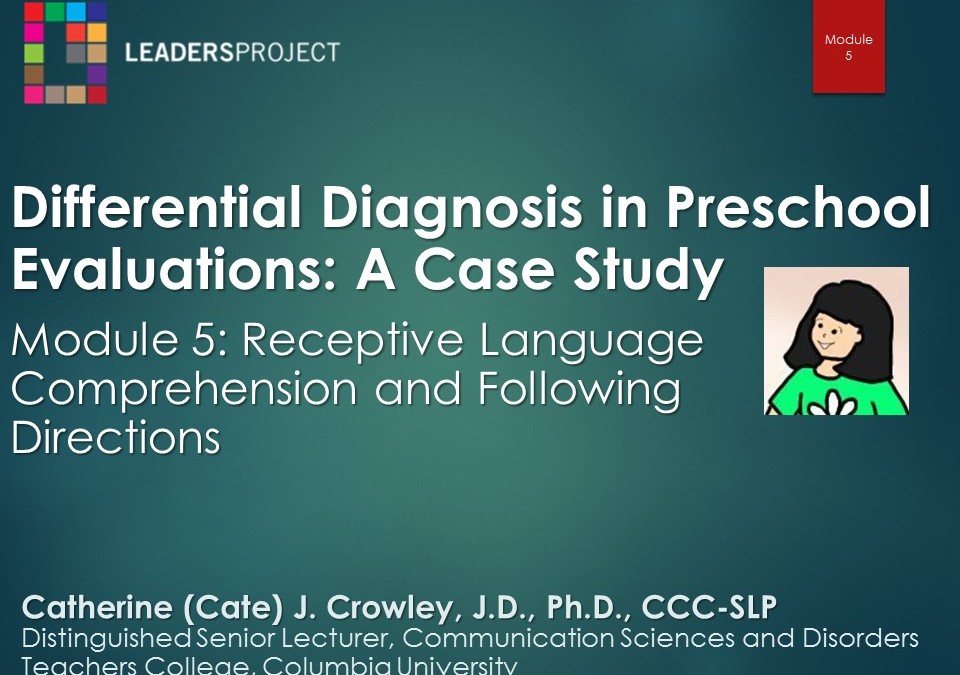In this video module Cate continues to look at the child’s receptive language skills using excerpts of auditory comprehension subtests from the PLS-5 English and Spanish editions. uses her clinical judgment to determine whether these skills are typical or not and also shows us some great tips for evaluating young children.
Cate continues to look at the child’s receptive language using excerpts of auditory comprehension subtests from the PLS-5 English and Spanish editions. However, note that they are being used to probe language skills and not to calculate scores. It is not appropriate to provide scores on standardized tests when those test lack validity or reliability or when they have significant cultural or racial biases. Moreover, evaluation materials cannot be used when they fail to distinguish disability from adequate instruction. Cate mentions that the SLP who was currently giving services to Alex, a Spanish-English bilingual, advised Alex’s mother not to use Spanish and English as it would “confuse” him. This is advice is NOT SUPPORTED BY RESEARCH. Whenever possible, the child’s language skills should be supported in both languages. Throughout this module, Cate uses her clinical judgment to determine whether skills the child exhibits are typical or not. Cate also shows us some great tips for evaluating young children, such as using favorite toys to observe them following two step directions. As in previous modules, Cate indicates where the information gathered from these probes should go in the final evaluation.
Please find related materials here:
Model Eval: 2;10-English/Spanish- Verbal Apraxia
Model Eval: 2;10- Verbal Apraxia IEP Goals
Current Research on Non-Speech Oral Motor Exercises
Find the playlist for the full set of videos in this module series here:
Differential Diagnosis in Preschool Evaluations: A Case Study (DDPE Playlist)
Find each of the modules from this playlist here:
Module 1: Why an Accurate Differential Diagnosis Matters
Module 2: Critical Questions for the Parent Interview Part 1
Module 3: Critical Questions for the Parent Interview Part 2
Module 4: Academic Language Expressive and Receptive Language
Module 5: Receptive Language Comprehension and Following Directions
Module 6: Eliciting Quality Narratives in Expressive Language
Module 7: Motor Speech, Articulation, and Speech Sound Inventory
Module 8: Dynamic Assessment: Nonword Repetition, Syllable and Sentence Repetition
Module 9: Putting it All Together in the Written Evaluation Report
Module 10: Developing Appropriate Goals for the IEP
Please find links to research mentioned in this module here:
Horton-Ikard, R., & Ellis Weismer, S. (2007). A preliminary examination of vocabulary and word-learning in African-American toddlers from middle and low SES homes. American Journal of Speech-Language Pathology, 16, 381-392.
Paradis, J. (2005). Grammatical morphology in children learning English as a second language: Implications of similarities with specific language impairment. Language, Speech, and Hearing Services in Schools, 36(3), 172-187.
Paradis, J., Crago, M., Genesee, F., & Rice, M. (2003). French-English bilingual children with SLI: How do they compare with their monolingual peers? Journal of Speech, Language, and Hearing Research, 46(1), 113-127. http://jslhr.pubs.asha.org/article.aspx?articleid=1781119
Peña, E. D., & Quinn, R. (1997). Task familiarity: Effects on the test performance of Puerto Rican and African American Children. Language, Speech, and Hearing Services in Schools, 28, 323-332.


![[feed link]](/wp-content/plugins/rss-just-better/rss-cube.gif)